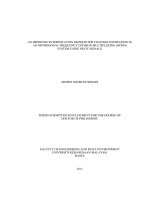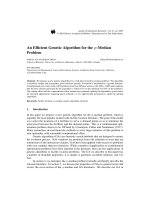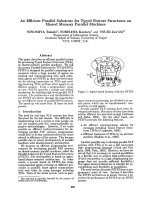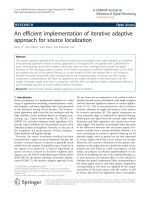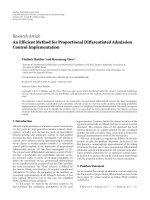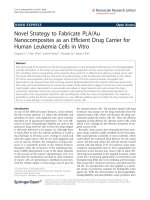Proposing an efficient implementation method for exponentiation in digital signature scheme on ring Zn
Bạn đang xem bản rút gọn của tài liệu. Xem và tải ngay bản đầy đủ của tài liệu tại đây (744.05 KB, 10 trang )
Information technology & Applied mathematics
Proposing an efficient implementation method for exponentiation
in digital signature scheme on ring Zn
Nguyen Dao Truong1*, Le Van Tuan2, Doan Thi Bich Ngoc3, Dang Duc Trinh4
1
Academy of Cryptography Technique;
Military Science Academy;
3
University of Information and Communication Technology, Thai Nguyen University;
4
Department of Information-Mathematics, Vietnam Military Medical University.
*
Corresponding author:
Received 08 Jun 2022; Revised 16 Aug 2022; Accepted 07 Nov 2022; Published 18 Nov 2022.
DOI: />2
ABSTRACT
In this paper, we propose a design method for the signature scheme based on ring structure Zn.
Our signature schemes are more secure, generate signatures at a faster rate than that of the ElGamal
scheme and its variants. Moreover, our approaches also overcome some disadvantages of some
similar signature schemes on ring Zn. For these advantages, they are fully applicable in practice.
Keywords: Digital Signature Scheme; Discrete logarithm problem; Hash function.
1. INTRODUCTION
Nowadays, a number of asymmetrical payment methods have been developed to
enable mobile users to buy goods online by charging them their mobile phone bills. It has
been recognized that these methods must be used in conjunction with the security services
of authentication and non-repudiation of the origin of the request(s) sent from a mobile
user so as to prevent fraudulent actions by any other entities. Therefore, proposing a
design method for a fast and secure signature scheme plays a very important role.
ElGamal’s digital signature scheme relies on the difficulty of computing the discrete
logarithm problem in the multiplicative group Z *p [1] and a series of variants of it [2, 3].
In general, the order of the multiplicative group Z *p of the ElGamal scheme and its
variants could not be kept secret. That leads to be insecure when the session key is
revealed or be coincided. Furthermore, these signature schemes publicize the order of
multiplicative group Z *p , which led to be insecurity when adversaries attacked them
from the Pollard’s Rho, the Pohlig Hellman, and the Index calculate algorithms [5]. In
order to deal with these insecure situations, recently scientists have proposed some
signature schemes on ring Zn[4, 6-9,11]. However, their schemes have not used the
Chinese Remainder Theorem (CRT) for faster computing exponentiation or faster
computing inverses [10]. This paper presents a Design Method of Digital Signature
Scheme in which the CRT was used for computing exponentiation and inverses. Our
research results can be applied in practice. Some important contributions of this paper
are as follows:
Firstly, proposing a design method for a digital signature scheme based on discrete
logarithm problems. Secondly, based on the proposed design method, we propose a
signature scheme that has overcome the disadvantage of the ElGamal digital signature
scheme and its variants. The speed of signature generation of the proposed schemes is
also faster than that of ElGamal scheme and its variants on ring Zn.
72
N. D. Truong, …, D. D. Trinh, “Proposing an efficient … digital signature scheme on ring Zn.”
Research
Section 2 presents notations and terminologies. In section 3, we propose some digital
signature schemes. In section 4, analysis of signature schemes and testing. Section 5
finally is the conclusion.
2. NOTATION AND TERMINOLOGY
In this section, we first introduce the notation and terminology, used in the article’s
following sections.
Element k is randomly chosen from the set X, k R X . The concatenation operation of
the string x with the string y, x||y. The bit-length of the binary representation of a,
denoted La. The order of g in ring Zn, denoted Ordn(g). The greatest common divisor of
integers a and b, denoted GCD(a, b). Discrete Logarithm Problem on ring Zn, denoted
DLPn. If n = p is prime, it is denoted DLPp.
Hash : 0,1 0,1
H
where H is a integer number. Let
s 0,1 , let
H
s s0 ...sH 2 sH 1 is a binary string. So s , that is computed by the following formula:
̅
. Let
, =
where
{ } (j =
– ) and
. Let H
, n[H] =
if H k.
n[H] = ⏟
nếu H > k. n H will return a H-bit string.
3. THE PROPOSED DIGITAL SIGNATURE SCHEME ON RING ZN
3.1. The generalized digital signature scheme - BSS
This section will propose a Design Method for Digital Signature Scheme Based on a
Discrete Logarithm Problem on ring .
The base set of the signature scheme: consists of five set (
) in which:
{ } is a finite set of messages.
is a finite set of signatures. ,
=
is a finite set of secret keys. ,
is a finite set of public keys.
is a
finite set of session keys.
General parameters of the system: The length size of modulo number , denoted ;
{ } , the length size of
Hash function, denoted Hash: { }
, denoted
and
.
The generalized formula: Computing key: let x is secret key, the public key, denoted
y,
. The first component of signatures is computed by the
[
]. The second
following formula:
(
)
where
component of the signatures is computed by the following formula:
.
Algorithm 1. Parameter of scheme BSS
Input:
Output: (
;
(
)
);
1. Generate two distinct odd primes the lengthsize of it is
bit and
lengthsize of
bit. Then compute ,
and compute
.
Journal of Military Science and Technology, No.83, 11 - 2022
73
Information technology & Applied mathematics
2. Generate two distinct odd primes
they satisfy some following
conditions:
|
|
and
,
3. Compute
,
,
4. Primitive element, denoted of multiplicative group, denoted
and its
order is with
, that is computed by the following formula:
with
5. Compute
and
.
6. Secret key is denoted by which is chosen randomly in
key is denoted by and that is computed
Set of parameters (
(
)
and set of parametures
are used for verifier.
Algorithm 2. Signature Generation of scheme BSS
Input: Message and parameters (
(
Output:
are a signature of message .
[
];
1.
;
2. if (
) (
) then goto 1;
3.
;
;
. The public
.
) are used for signer
)
).
;
(( (
)
)
)
;
;
4.
5.
6.
if ( = 0) then goto 1.
;
if (
) (
7.
;
;
;
) then goto 1;
;
(
(
)
)
;
;
8. return
;
Algorithm 3. Signature verification of scheme BSS
Input: Message m’s signature
; set of parameters
.
Output: Return
or
.
1. if
then return “reject”.
2.
; if ( = 0) theo return “reject”.
3.
;
;
;
.
4.
; if (
) then return “accept” else
“reject”;
Proof of correctness:
The success probability of algorithm 2 depends on the end of three loops (step 2, step
4 and step 6). Lemma 3 proved that, the probability of these loop-end-events are
approximately 1. So, the rest steps of algorithm 2 will terminate, obviously Algorithm 2
will success and return
of message m. The input of algorithm 3 include: the
74
N. D. Truong, …, D. D. Trinh, “Proposing an efficient … digital signature scheme on ring Zn.”
Research
signature of message m is denoted
valid signature of message m then
proved as follows:
(
;
Then do following:
So
and (public key). Obviously, if
is a
and the value of equals value that will be
)
;
;
=
.
Then do following
)
=
is computed by algorithm 5 following:
Value
((
(1)
)
)
(2)
From formulas (1) and (2) that proved that
, algorithm 3 will terminate with
success and to return “accept”.■
3.2. Proposed signature scheme - SS01
The contents presented in this subsection are defining function
and
and proposing a signature scheme. The functions
and
are defined as
̅̅̅̅̅̅̅̅̅̅̅̅̅̅̅̅̅̅̅
follows. Functions
) =1;
|| [ ] .
We have the proposed signature scheme, denoted SS01, which consists of the signing
algorithm, the signature verification algorithm. With the parameter generation algorithm
that was inherited from BSS.
Algorithm 4. Generation signature of SS01
Input: Message ; Set of parameters (
(
)
).
Output:
is the signature of message .
[
];
1.
;
;
2. if (
) (
) then goto 1;
3.
;
;
(( (
)
)
)
;
̅̅̅̅̅̅̅̅̅̅̅̅̅̅̅̅̅̅̅
4.
|| [ ] ;
;
;
;
5. if (
) (
) then goto 1;
6.
;
;
( (
)
)
;
7.
; return (r, s).
Algorithm 5. Signature verification of scheme SS01.
Input:
is the signature of message m; public key
.
Output: Return
or
.
1. if (s = 0) then return “reject”;
̅̅̅̅̅̅̅̅̅̅̅̅̅̅̅̅̅̅
2.
|| [ ]).
3. if (w = r) then return “accept” else “reject”;
Proof of correctness: In subsection above, we showed that digital signature scheme,
denoted BSS is correct so scheme SS01 is correct.■
3.3. Proposed signature scheme - SS02
Journal of Military Science and Technology, No.83, 11 - 2022
75
Information technology & Applied mathematics
The functions, denoted
and
that are defined as follows.
Function
) =̅̅̅̅̅̅̅̅̅̅̅̅̅̅̅̅̅̅̅
|| [ ] ;
1.
Algorithm 6. Signature generation of SS01
Input: Message ; Set of parameters (
(
)
Output:
is the signature of .
[
];
1.
;
;
2. if (
) (
) then goto 1;
3.
;
;
(( (
)
)
)
)
;
̅̅̅̅̅̅̅̅̅̅̅̅̅̅̅̅̅̅
4.
|| [ ]); if ( = 0) then goto 1.
5.
;
mod ;
;
;
6. if (
) (
) then goto 1;
7.
;
;
( (
)
)
;
8.
; return (r, s);
Algorithm 7. Signature verification of SS02
Input: The consists of parameters
; The
is the signature of
Output: Return “accept” or reject .
1. if
then return “reject”
̅̅̅̅̅̅̅̅̅̅̅̅̅̅̅̅̅̅
2.
|| [ ]), if (
0) then return “reject”.
3.
;
;
;
;
4.
Proof of correctness: In subsection above, we proved that the scheme BSS is correct
so scheme SS02 is correct. ■
4. ANALYSIS OF THE SIGNATURE SCHEME AND TESTING
Suppose that, the bitlength of the modulus number (denoted ) of the proposed schemes
and the RSA scheme equal,
, in which and
are
bit primes. Suppose
. Let the modulus number of ElGamal’s scheme (denoted ) is a
bit prime,
. Suppose that
,
and
. The cost
of computing of ElGamal scheme and RSA scheme [12] were reviewed in this paper.
4.1. Computational complexity
Let the number of bits in the binary representation of two positive integers a and b is
bit, the number of bit operations of the modular multiplication of and is denoted
. Assume that the modular exponentiation operation
is denoted function
.
Lemma 1:
Recall that, consists of
are
bit) non-negative integers. The number
of bit operations of the function
=
is denoted
, it is
estimated as follows:
.
.
(3)
Proof:
76
N. D. Truong, …, D. D. Trinh, “Proposing an efficient … digital signature scheme on ring Zn.”
Research
Recall that
be the bitlength of the binary representation of . Let
be the
bitlength of the binary representation of e and let w(e) be the number of 1 is in
representation of . The using of efficient modular multiplication and exponentiation
algorithms for computing function
=
requires
of
multiplication and w(e) of squaring in . According to [5],
. If squaring is
approximate as costly as an arbitrary multiplication then
is roughly the
following formula:
■
Lemma 2. Let the bit-length of value n, denoted
. Recall that the
roughly equal bit-length. If modulus n is factored as follows:
and
and n of
. Then computing
can execute be approximately 4 times faster and
computing
can execute be approximately 4 times faster
Proof:
(i) Suppose p and q are L-bit primes, and let n = p.q. if not having n = p.q then
according to Lemma 1 to compute
requires
bit
operations. On the other hand, having n = p.q, then according to [5] that compute
mod and
mod (in which
= mod (
) and = e mod (
) require
2.( . ) bit operations. So the speed of computing
is about
times
faster.
(ii) Suppose p and q are L-bit primes and let n = p.q. According to [5], if not having n
= p.q, compute
requires
=
. On the other hand, if having n = p.q,
then according to [5] that compute
and
require
bit
operations. So, the speed of computing
is about
times faster.
Lemma 3. Suppose that is a generator α of the unique cyclic group of order t in ring
(
). Let
are distinct primes, each roughly the same size and satisfying
. The probability of the loop in proposed schemes is executed only one
time be approximately 1 when
.
Proof:
Apparently the probability of the loop in proposed schemes is executed only one time
when consists of events (
) or (
) or (
) or (
) occur from the
first loop. The consists of event (
), (
), (
), (
) just occur
with the probability (when
so
or
or
or
). Since
,
with
. Furthermore, the hash function is based on the secure
̅̅̅̅̅̅̅̅̅̅̅̅̅̅̅̅̅̅
hash Algorithm, such as SHA-1, so (
|| [ ] )
with the probability 1■
4.2. Computational costs
What remains in this session are some analysis and comparison of the computational
costs? We focus mainly on analyzing the number of bit operations of the modular
multiplication, the modular exponentiation, and the modular inverses in consists of the
Journal of Military Science and Technology, No.83, 11 - 2022
77
Information technology & Applied mathematics
proposed schemes, ElGamal’s Scheme and the RSA scheme. The Inverses in
can be
computed by using the extended Euclidean algorithm. According to [5], computing an
inverse in
is as approximately costly as modular multiplication. In Lemma 3, It
proved that the loop event executes once with the probability 1, so we suppose that the
algorithm of the proposed schemes hasn’t the loop. Algorithm 4, if excluding addition,
subtraction, modulus reduction then the computational costs of algorithm as follows: two
exponentiations in
these require
bit-operations; one multiplication in ,
and requires
bit operations; two inverses in
and
that require 2
bit
operations; two multiplications in
algorithm 4 are 3
and require
bit operations. So, the total cost of
+
bit operations. In algorithm 5, if excluding
the modulus reduction and the checking (
) then the computational costs of
algorithm 5 is: two exponentiations ( -bit exponents and
-bit exponents) and one
multiplication in . So, the total of computational cost of algorithm 5 is 1,5.
bit operations.
Algorithm 6, if excluding addition, subtraction, modulus reduction then the
computational costs of algorithm following: 3
+
bit operations.
In algorithm 7, if excluding the modulus reduction and the checking (
) then the
computational costs of algorithm 7 is as approximately costly as the computational costs
of algorithm 5, then the expected amount of bit operations is about
.
4.3. Storage space costs
Each signature is generated by the proposed schemes that require storage 2
bit, it
is much smaller than the storage space consists of ElGamal’s signature, RSA’s signature.
If we review the proposed schemes (SS01 scheme, SS02 scheme) in the generalization
case, each member of the system own a set of individual parameters (consists of 11
components require
bit), and their storage space requirement depends on the
number of members in the system. Recall that, the proposed signature scheme has K
members, the proposed schemes required storage space be
bit, in which
is the convolution instances k of n elements. Therefore, the proposed schemes require
a storage space that are much larger than the storage space of ElGamal’s scheme and its
variant schemes on the field . The results of the estimation of the computational cost
and storage space of the proposed signature scheme are shown in table 1.
Table 1. Number of bit operations and storage spaces.
Signature
Signature generation
Verification
Signature
Scheme
(number of bit
Parameter spaces
number of bit
spaces
operations)
operations
.
128.
RSA
.
+3.
9.L.
+ 2.
ElGamal
SS01
SS02
78
N. D. Truong, …, D. D. Trinh, “Proposing an efficient … digital signature scheme on ring Zn.”
Research
4.4. Security analysis
Proposition 1. The proposed schemes are secure from the situations of coinciding or
revealing of session key
Proof: Ideally, a session key is an ephemeral secret, that is generated in each
transaction. According to the “birthday paradox”, the possibility of key revealing still
occurs quite high. However, the order of primitive element (denoted
) of the
proposed signature schemes was kept secret, so it is secure against attacks of revealing or
coinciding session key:
(i) Review algorithm 4 (scheme SS01) and algorithm 6 (scheme SS02). Recall that, a
session key (denoted k) was revealed, because t is kept secret, so adversaries cannot
determine from the following formula:
mod . Since it is impossible
to determine w, so it can’t determine x and our proposed scheme can’t be forged by
adversaries.
(ii) Review algorithm 4 (scheme SS01) and algorithm 6 (scheme SS02). Recall that, a
session key (denoted k) coincided, because t is kept secret, so adversaries can’t
determine from the following formula:
mod . So it can’t determine x
from
mod . Therefore, our proposed scheme can’t be forged by
adversaries.
Proposition 2: The proposed signature schemes avoid the attacking by Pohlig
Hellman algorithm, Pollard's Rho algorithm and Index calculate algorithm.
Proof: It can be seen that the proposed signature schemes are secure as an integrity
mechanism, since the inputs of all the above algorithms must have the order of the
generator element g, (denoted
). Because t is kept secret, so adversaries
can‘t determine x by using the Pohlig Hellman algorithm, the Pollard's Rho algorithm
and the Index calculate algorithm.
Safety threshold: Similar to the digital signature schemes being applied in practice, in
order to apply the two proposed signature schemes SS01 and SS02 in practice, the
security threshold must first be determined[11] and its safety parameter standards[4] at
application time. The determination of safety thresholds and safety standards will be
presented by the authors in the next articles.
4.5. Testing simulation
Generation time (s)
Signature Generation
4.00
3.00
2.00
1.00
0.00
1024
1280
1536
1792
2048
Key size (bit)
RSA
ElGama
DSA
SS01
SS02
Figure 1. Signature generation times of different schemes.
Journal of Military Science and Technology, No.83, 11 - 2022
79
Information technology & Applied mathematics
Recall that,
1024, 1280, 1536, 1792, 2048 (bit). The message’s size
of the testing is
. The Computer’s configuration is CPU Intel(R)
Core(TM)2/3.00GHz, the physical memory 2 Gbyte. The hash function used for testing
be the
. The results of testing are shown in figure 1 and figure 2.
Verification time (s)
Signature Verification
5.00
4.00
3.00
2.00
1.00
0.00
1024
1280
1536
1792
2048
Key size (bit)
RSA
ElGama
DSA
SS01
SS02
Figure 2. Signature verification times of different schemes.
Figures 1 and 2 show that the signing speed of our two proposed schemes is
approximately 50 times faster than it of RSA and ElGamal. In addition, our two
proposed schemes also have 10 times faster signing speed than DSA’s signature scheme.
However, for signature verification, the verification speed of our two proposed schemes
is slower than that of other schemes. This is because our verification technique is not
optimal. In the next research time, we will improve this for better.
5. CONCLUSIONS
In this paper, we proposed a Design Method for Digital Signature Scheme Based on
Discrete Logarithm Problem. We proposed a method for designing digital signature
schemes based on the discrete logarithm problem in this article. The proposed scheme’s
security is based on the discrete logarithm problem on ring , (denoted
in which
n is a product of two primes. With this approach, in our scheme, the order of primitive
elements (denoted
(g)) can be kept secret, so it is secure against not only session
key revealing or session key coinciding situations but also using algorithms solving such
as Pollard's Rho algorithm, the Pohlig Hellman algorithm or the Index algorithm
calculate algorithm. Even the CRT was applied for computing exponentiation and
inverses in our proposed schemes, so its signature generation speed is faster than that of
similar schemes on ring . Therefore, they are suitable for smart cards. Admittedly, our
proposed scheme’s storage space costs are much larger than the similar scheme’s storage
space costs.
REFERENCES
[1]. Dimitrios Poulakis and Robert Rolland. “A Digital Signature Scheme based on two hard
problems.” />[2]. Ng, Tiong-Sik, Syh-Yuan Tan, and Ji-Jian Chin. “A variant of Schnorr signature scheme
with tight security reduction.” 2017 International Conference on Information and
Communication Technology Convergence (ICTC). IEEE, (2017).
80
N. D. Truong, …, D. D. Trinh, “Proposing an efficient … digital signature scheme on ring Zn.”
Research
[3]. Morita, Hiraku, et al. “On the security of the schnorr signature scheme and DSA against
related-key attacks.” ICISC 2015. Springer, Cham, (2015).
[4]. Tuan Le Van, “Developing and constructing parameters for digital signature scheme on
discrete logarithmic problem by composite modulus” Military Technical Academy, PhD
thesis, Ha Noi, (2019).
[5]. Alfred J. Menezes, Paul C. van Oorschot, Scott A. Vanstone, “Handbook Applied
Cryptography”, Webster Professor of Electrical Engineering and Computer Science
Massachusetts Institute of Technology June (1996).
[6]. Duy Ho Ngoc, Van Vu Long,Tuan Nguyen Kim, Thuy nguyen Thi Thu, “A Solution to
improve security for digital signature scheme”, SOIS Ho Chi Minh City, No 2, pp.13-16,
(2017).
[7]. Berezin, A. N., N. A. Moldovyan, and V. A. Shcherbacov. “Cryptoschemes based on
difficulty of simultaneous solving two different difficult problems.” Computer Science 21.2:
62 (2013).
[8]. Meshram, Chandrashekhar. “Discrete Logarithm and Integer Factorization using ID-based
Encryption.” Bulletin of Electrical Engineering and Informatics 4.2: 160-168 (2015).
[9]. Tripathi, Shailendra Kumar, and Bhupendra Gupta. “An efficient digital signature scheme
by using integer factorization and discrete logarithm problem.” 2017 International
Conference on Advances in Computing, Communications and Informatics (ICACCI).
IEEE, (2017).
[10]. “Cryptographic Mechanisms: Recommendations and Key Lengths”, TR-02102-1 v2020-01,
BSI, (03/ 2020).
[11]. Lê Văn Tuấn, Tạ Minh Thanh và Bùi Thế Truyền, “Phát triển lược đồ chữ ký số Elgamal
trên vành Zn ngăn ngừa tấn cơng dựa vào tình huống lộ khóa phiên hoặc trùng khóa
phiên” , Tạp chí ITC, số 13 (6-2019), (in Vietnamese).
TÓM TẮT
Đề xuất một phương pháp thiết kế lược đồ chữ ký số
dựa trên bài toán logarit rời rạc trên vành Zn
Trong bài báo này, chúng tôi đề xuất một phương pháp thiết kế lược đồ chữ ký
số dựa trên độ khó của bài tốn logarit rời rạc trên vành Zn. Những lược đồ đề
xuất của chúng tôi an toàn hơn, việc tạo chữ ký được thực hiện nhanh hơn so với
lược đồ ElGamal và các biến thể của nó. Ngồi ra, phương pháp thiết kế đề xuất
của chúng tơi cũng có các chi phí tốt hơn so với các lược cùng loại trên vành Zn.
Lược đồ đề xuất của chúng tơi có thể được áp dụng trong thực tế về sau.
Từ khoá: Digital Signature Scheme; Discrete logarithm problem; Hash Function.
Journal of Military Science and Technology, No.83, 11 - 2022
81
